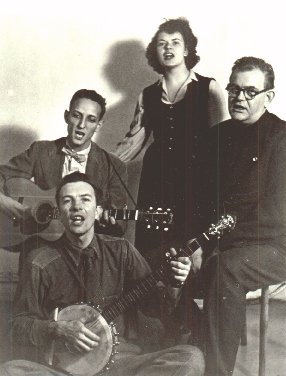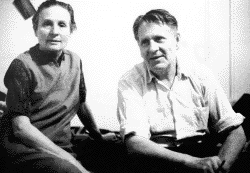Bob Dylan, A Disciple of Woody Guthrie

If you were on a college campus in the 1960s, you had the opportunity to go to any number of coffeehouses and folk cafes in and around university centers. At Michigan State University, where I spent four years, I still remember hearing Josh White Jr. in a little coffeehouse not far from campus in 1964. University coffeehouses were just one of many venues open to young folk singers. Those who garnered a national following usually found their way to New York City, especially Greenwich Village. The Village was the “scene” for any folksinger hoping to hone their craft or possibly find a publisher for their music. From Greenwich Village cafes some made it big and went on the road playing sold out concerts in cities and university communities across the country. In 1964, Bob Dylan played over 200 concerts a year.

Bob Dylan was born Robert Allen Zimmerman in Duluth Minnesota in 1942. He learned to play the guitar and harmonica in high school and formed the Golden Chords band. Dylan attended the University of Minnesota for three semesters in 1959. It was during this period that he started performing in coffeehouses and started using the name, Bob Dylan. (he made it legal in 1962). Dylan moved to New York City in 1961, where he could be close to the folk scene. He was also anxious to meet Woody Guthrie. At this time, Guthrie was hospitalized with Huntington’s chorea. Dylan copied Woody’s style and recorded more than forty of Woody’s songs. An article in Time Magazine in 1963 described Dylan as a disciple of Guthrie, …”a promising young hobo named bob Dylan. He is 21 and comes from Duluth. He dresses in sheepskin and a black corduroy Huck Finn cap, which covers only a small part of his long, tumbling hair. He makes visits to Woody Guthrie’s hospital bad, and he delivers his songs in a studied nasal that has just the right clothespin-on-the-nose honesty to appeal to those who most deeply care.”

But, Bob Dylan’s popularity stems more from his uniqueness than his ability as a folk singer. His songs added a new freshness to a genre that seemed to be moving away from the authenticity of the folk song that expressed the human experience. In an article in Look Magazine in 1963, the author discussed how folk songs had changed from an earlier era when Pete Seeger and Woody Guthrie popularized the genre. The owner of one of New York City’s most successful folk establishment explained it this way, “Seeger? Yeah, he’s great. But he’s, like, ethnic, you know? If I put that kind of stuff on, I’d go broke in a week.” Instead of the more controversial singers like Pete Seeger, folk fans wanted to see and listen to groups like The Kingston Trio, The Chad Mitchell Trio and Peter, Paul and Mary (all to be highlighted in future blogs.) These groups, moved away from the originality of folk to a more salable, if not bland, product, which folk fans loved because many of them played guitars and banjos and sang the songs. Dylan was different. The songs he sang and wrote were not ethnic or overly sanitized. Although he sang many of Guthrie’s songs, he wrote his own songs about everyday things and about how he viewed the world around him. In a way, he created a new genre by ”performing his allusive, poetic songs in his nasal spontaneous vocal style with an electric band.” And, his style crossed over several genres; he felt comfortable in folk, country, pop and rock and roll. But his roots are in folk, especially the work of Woody Guthrie.

Click on Bob for interview
When Dylan arrived in New York City in 1961, he captured his impression of New York City and Greenwich Village in his song, “Talkin’ New York, “ a style used by Guthrie and Seeger in “Talkin’ Union.” Probably the song that had universal acceptance in the 1960s was Dylan’s “Blowin in the Wind”(1963), which became a folksinger’s standard; almost every folk group included the song in their repertoire. As a songwriter, Dylan wears many hats, but his songs of protest equal those of Pete Seeger and Woody Guthrie.
Bob Dylan singing "Blowin in the Wind" 1963
The Bob Dylan song that fascinates me most is one that he included in his 1975 release of Blood on the Tracks album-- “Lily, Rosemary and the Jack of Hearts. ” The song is a very long ballad that is open to many interpretations, Dylan has not told anyone what the song really means. When I first heard the song on a Joan Baez album, I immediately thought of a wide-open town in the Frontier West, no doubt the western historian in me jumping to conclusions. Regardless, “Lily, Rosemary and the Jack of Hearts” is a fascinating song; one the listener has to hear several times to begin to understand the story. Below are the lyrics, and the Joan Baez and Dylan’s rendition of the song.
Leave your interpretation in the comments at the end of this blog, I would love to read them.
Bob Dylan Sing "Lily, Rosemary And The Jack Of Hearts"
Lily, Rosemary And The Jack Of Hearts
The festival was over, the boys were all plannin' for a fall,
The cabaret was quiet except for the drillin' in the wall.
The curfew had been lifted and the gamblin' wheel shut down,
Anyone with any sense had already left town.
He was standin' in the doorway lookin' like the Jack of Hearts.
He moved across the mirrored room, "Set it up for everyone," he said,
Then everyone commenced to do what they were doin' before he turned their heads.
Then he walked up to a stranger and he asked him with a grin,
"Could you kindly tell me, friend, what time the show begins?"
Then he moved into the corner, face down like the Jack of Hearts.
Backstage the girls were playin' five-card stud by the stairs,
Lily had two queens, she was hopin' for a third to match her pair.
Outside the streets were fillin' up, the window was open wide,
A gentle breeze was blowin', you could feel it from inside.
Lily called another bet and drew up the Jack of Hearts.
Big Jim was no one's fool, he owned the town's only diamond mine,
He made his usual entrance lookin' so dandy and so fine.
With his bodyguards and silver cane and every hair in place,
He took whatever he wanted to and he laid it all to waste.
But his bodyguards and silver cane were no match for the Jack of Hearts.
Rosemary combed her hair and took a carriage into town,
She slipped in through the side door lookin' like a queen without a crown.
She fluttered her false eyelashes and whispered in his ear,
"Sorry, darlin', that I'm late," but he didn't seem to hear.
He was starin' into space over at the Jack of Hearts.
"I know I've seen that face before," Big Jim was thinkin' to himself,
"Maybe down in Mexico or a picture up on somebody's shelf."
But then the crowd began to stamp their feet and the house lights did dim
And in the darkness of the room there was only Jim and him,
Starin' at the butterfly who just drew the Jack of Hearts.
Lily was a princess, she was fair-skinned and precious as a child,
She did whatever she had to do, she had that certain flash every time she smiled.
She'd come away from a broken home, had lots of strange affairs
With men in every walk of life which took her everywhere.
But she'd never met anyone quite like the Jack of Hearts.
The hangin' judge came in unnoticed and was being wined and dined,
The drillin' in the wall kept up but no one seemed to pay it any mind.
It was known all around that Lily had Jim's ring
And nothing would ever come between Lily and the king.
No, nothin' ever would except maybe the Jack of Hearts.
Rosemary started drinkin' hard and seein' her reflection in the knife,
She was tired of the attention, tired of playin' the role of Big Jim's wife.
She had done a lot of bad things, even once tried suicide,
Was lookin' to do just one good deed before she died.
She was gazin' to the future, riding on the Jack of Hearts.
Lily washed her face, took her dress off and buried it away.
"Has your luck run out?" she laughed at him, "Well, I guess you must
have known it would someday.
Be careful not to touch the wall, there's a brand-new coat of paint,
I'm glad to see you're still alive, you're lookin' like a saint."
Down the hallway footsteps were comin' for the Jack of Hearts.
The backstage manager was pacing all around by his chair.
"There's something funny going on," he said, "I can just feel it in the air."
He went to get the hangin' judge, but the hangin' judge was drunk,
As the leading actor hurried by in the costume of a monk.
There was no actor anywhere better than the Jack of Hearts.
Lily's arms were locked around the man that she dearly loved to touch,
She forgot all about the man she couldn't stand who hounded her so much.
"I've missed you so," she said to him, and he felt she was sincere,
But just beyond the door he felt jealousy and fear.
Just another night in the life of the Jack of Hearts.
No one knew the circumstance but they say that it happened pretty quick,
The door to the dressing room burst open and a cold revolver clicked.
And Big Jim was standin' there, ya couldn't say surprised,
Rosemary right beside him, steady in her eyes.
She was with Big Jim but she was leanin' to the Jack of Hearts.
Two doors down the boys finally made it through the wall
And cleaned out the bank safe, it's said that they got off with quite a haul.
In the darkness by the riverbed they waited on the ground
For one more member who had business back in town.
But they couldn't go no further without the Jack of Hearts.
The next day was hangin' day, the sky was overcast and black,
Big Jim lay covered up, killed by a penknife in the back.
And Rosemary on the gallows, she didn't even blink,
The hangin' judge was sober, he hadn't had a drink.
The only person on the scene missin' was the Jack of Hearts.
The cabaret was empty now, a sign said, "Closed for repair,"
Lily had already taken all of the dye out of her hair.
She was thinkin' 'bout her father, who she very rarely saw,
Thinkin' 'bout Rosemary and thinkin' about the law.
But, most of all she was thinkin' 'bout the Jack of Hearts.
Copyright ©1974 Ram's Horn Music

Bob Dylan began to express himself through his drawings and paintings. In October 2008, the Kunstsammlungen Art Museum in Chemnitz Germany, exhibited Dylan’s artwork, sketches made between 1989 and 1992.

















 Click on Arlo Guthrie for clip
Click on Arlo Guthrie for clip








